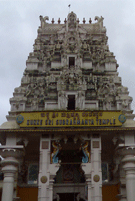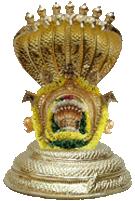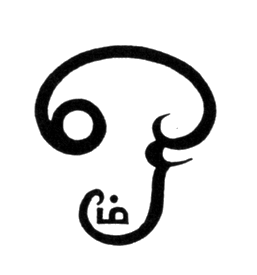
Kukke Subramanya Temple
www.kukke.org
Murugan Temples
http://murugan.org/temples/index.htm.
Murugan Temples are found all over India and in many other countries but predominantly in South India especially Tamil Nadu. Famous ones include those at Palani · Thiruchendur · Swamimalai · Thiruthani · Pazhamudircholai · Thiruparamkunram · Subramanya · Marudamalai · Chennimalai · Thindalmalai · Sikkal · Vayalur · Viralimalai · Kunrakudy · Malai Mandir · Nallur · Batu Caves · Brickfields · Kathirkamam
The first six represent the Arupadai Veedu or the six holy abodes. The last three are outside India (Malaysia an Sri Lanka)
May, 2011
The following article was provided by R. Sivaramakrishna Sharma, and has been published in several parts in the Dhandapani Group dedicated to discussions on Murugan (dhandapani@yahoogroups.com). (Part 1 & 2 provided so far, rest will added when ready). I thank Sri Sharma for this beautiful article.
Part 1
The benevolent Lord of Six faces – Shanmukha, has performed many a deed of sport for the upliftment of His devotees and the pious in general. In doing so He has manifested at various sacred spots at various points of time in the Divine creation and these have come to be venerated and worshipped by Rishis, Munis and common people since then. Of these, Kukke Sri Subrahmanya Kshetram is considered sacred and one among the seven sacred places in the Parashurama Srishti in the Bharata Khanda.
 Located in the sky-scrapping Western Ghats, Kukke Subrahmanya Kshetram is situated amongst dense tropical forests abundant with flora and fauna, in the Dakshina-Kannada (South Kanara) district in the South Indian state of Karnataka and draws innumerable devotees throughout the year from all over India, primarily from South India. Until the mid 20th century, a pilgrimage to Kukke Subrahmanya Kshetram was equivalent to a pilgrimage to Kailasa itself, in terms of hardships due to lack of proper transportation infrastructure. Only in the mid 70's were proper roads and connecting infrastructure developed by the State Government and since then influx of Pilgrims has been increasing.
Located in the sky-scrapping Western Ghats, Kukke Subrahmanya Kshetram is situated amongst dense tropical forests abundant with flora and fauna, in the Dakshina-Kannada (South Kanara) district in the South Indian state of Karnataka and draws innumerable devotees throughout the year from all over India, primarily from South India. Until the mid 20th century, a pilgrimage to Kukke Subrahmanya Kshetram was equivalent to a pilgrimage to Kailasa itself, in terms of hardships due to lack of proper transportation infrastructure. Only in the mid 70's were proper roads and connecting infrastructure developed by the State Government and since then influx of Pilgrims has been increasing.
The temple of Lord Subrahmanya Swami at Kukke Subrahmanya Kshetram has an imposing (relatively speaking) Gopuram that leads the devotee into a large hall. Inside the hall one can see a Ranga-Mantapa on the right side, constructed recently for the purpose of conducting cultural programmes during festivals, and entrance to the Anna-Dana Mantapa on the left, where pilgrims are fed daily with Mahaprasada, except on Ekadashi. Further down a flight of steps leads one into the main temple complex – the Chandra Shala. Unlike most temples, the Raya Gopuram of Kukke Subrahmanya Kshetram is West Facing for one very prominent reason – beyond the the East gate is the famed and legenday Kumara-Dhara Tirtha (a river) and beyond the the opposite bank of the river are a series of legendary and inaccessible mountains. Thus having a Raya Gopuram on the east would not serve any practical purpose. In Hindu tradition it is customary to worship and propitiate a deity, approching the murti clockwise. So is pradakshina done clockwise, for it is considered inappropriate, inauspicious and a lack of respect to do it otherwise. Approaching the temple entrace, clockwise, on the Northern causeway, there is a mantapa where temple priests sit and perform sankalpa for devotees offering pujas etc. On the North Eastern Corner is located the Sringeri Math, housing the shrine of Lord Chandramouleeshwara. Midway in the eastern Causeway is the Deepa Mantapa which is located just outside the main entrance of the Temple. East of the Deepa Mantapa is a huge wooden door that is followed by a flight of steps that leads to the legendary Kumara-Dhara Tirtha, where a nice bathing ghaut with roof has been constructed for pilrims who wish to take bath in the river. Upon entering the temple, there is a statue of a King by name Ballala Raya in a veranda adjacent to the door. Further west, inside the temple there is a Dhwaja Stambha beyond which there is the Shrine which houses the Sanctum Sanctorum (Garbha Griha) of Lord Subrahmanya Swami, flanked by Dwara Palakas on each side outside the Ardha Mantapa. The Moolavar – Sri Subrahmanya Swami is a small murti of Lord Shanmukha on top of the Mayil Vahanam placed on a relatively high Peetham. Below the Peetham are two Naga-Murtis (murtis of two serpents) with five heads each – Adi Shesha below and Vasuki on top. Below the Naga Murtis is said to be a divine (daiviya) 'Puttru' – a serpent dwelling in which, according to Legend Vasuki still resides. As with all traditional temples, the entire Garbha Griha is lit with only traditional oil lamps and there is no electrical lighting inside the Garbha Griha. The Lord of the Universe with Six Faces and twelve hands is flanked by Shesha on top. Pujas, Abhisheka, Aratis are performed daily in accordance with the Agama Scriptures.
Part 2
After Darshan of Sri Subrahmanya Swami at the main temple, coming clockwise (in Pradakshina), one has the Darshana of Sri Bhairava. Local legends speak of a vigraha of Sri Kapaleeshwara being installed by Lord Subrahmanya Swami. Kapaleeshwara is an epithet of Lord Shiva. Lord Bhairava is also known by the name of Kapaleeshwara and the murti looks ancient. However, the temple authorities and other experts are of the consensus that this was not the original place where the murti of Lord Bhairava was consecrated and that the exact location where Lord Subrahmanya had installed in unknown. The shrine of Lord Bhairava is located in the Southern Chandrashala (South to the main sanctum sanctorum) in the inner prakara facing North.
In the Western part of the Chandra-Shala is a shrine of Lord Shiva, worshipped here as Kukke-Linga.Regarding the name 'Kukke' various plausible explanations are given which will be dealt later. This Kukke-linga is the Kula-Devata for many families who reverentially worship the Lord with devotion. This Shiva Linga is also said to have been consecrated by Lord Subrahmanya Swami, although the present location is not the place where Lord Subrahmanya is said to have installed it.
In the Norther part of the inner Chandra Shala towards the North-East, is situated the shrine of Sri Uma Maheshwara. Sri murtis of Uma-Maheshwara are relatively small and are not bound to the garbha-griha by means of a bandhana. Rather they are relatively small silver murtis placed in ornate mantapa and worshipped. Apart from the murti of Sri Uma Maheshwara, one also has the Darshana of Sri Ganapati, Sri Ambika, Sri Mahavishnu and Sri Suryanarayana. According to legend, the murtis of Sri Suryanarayana and Sri Ambika are ancient said to have been consecrated by Davarshi Sri Narada himself. In time people belonging to the Bhagavata tradition propounded by Sage Narada collected these murtis and installed them at the present shrine.
After Darshana of Sri Uma Maheshwara one completes Pradakshina of the shrine of Lord Subrahmanya Swami. Coming out and continuing clockwise one crosses the Deepa Mantapa and has the Darshana of Veda-Vyasa Samputa Nrisima Deva.According to legend, this was the place where Sri Mahaganapati was originally installed and worshipped. However now the murti of Sri Mahaganapati is inside the main sanctum sanctorum of Sri Subrahmanya Swami. Continuing, it is said that the murti of Vedavyasa Samputa and Sri Lakshmi Nrisimha Deva were handed down to Sri Madhvacharya (Sri Ananda Tirtha of Dwaita Vedanta fame) by Sri Veda-Vyasa himself. However personally this legend seems unlikely as, if the vigraha were to be of such paramount importance, it would have been in Udupi where the prime Ashta-Maths of Madhvacharya are located. This vigraha belongs to the Swamijis of the Subrahmanya Math (a Madhva Math) who worship the deity. Inside the shrine of Sri Vedavyasa Samputa Nrisimha Deva is also located the shrine of Sri Mukhya-Prana, one of the main deities in the Madhva tradition.
Continuing, in the outer prakara,in the Southern part is the shrine of Hosagaligamma and Purusharaya. These two deities are the Kshetra-Palakas of Sri Subrahmanya Kshetram and they are refered to as Vatayakshini and Chandila in the Skanda Mahapurana. It is customary for devotess to offer sevas like kumkumarchana, mangalarti etc. at this shrine.
Proceeding further in the Northern Prakara, one can see a door and a road leading outside. This road leads one to another temple closeby known as Adi Subrahmanya.
To be continued ...

